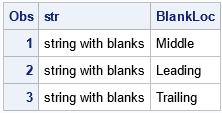A SAS programmer noticed that his SAS output was not displaying multiple blanks in his strings. He had some strings with leading blanks, others with trailing blanks, and others with multiple blanks in the middle. Yet, every time he used SAS to print the strings to the HTML destination, something mysterious happened. The leading and trailing blanks vanished and the multiple blanks in the middle of strings were replaced by a single blank.
No, this isn't a bug in SAS, it is a feature of the HTML renderer. The HTML renderer intentionally "eats" blanks and other whitespace. HTML is a popular destination for SAS output, but be aware the strings you see in an HTML table might not accurately show the blank characters in the underlying text.
This article demonstrates the issue, then shows how a programmer can discover the location of blanks in SAS character values.
HTML compresses multiple blanks
The following DATA step creates strings that have multiple blanks in the middle of a string, at the beginning of a string, and at the end of a string:data BlankTest; length str $ 30; BlankLoc = 'Middle '; str = ' string with blanks '; output; BlankLoc = 'Leading '; str = ' string with blanks'; output; BlankLoc = 'Trailing'; str = 'string with blanks '; output; run; /* note that the multiple blanks do not appear when you display them in HTML */ ods HTML; proc print data=BlankTest; run; |

The output shows why the SAS programmer was confused: the strings all look the same! Although he had explicitly constructed strings that contained multiple blank characters, his PROC PRINT output (in the HTML destination) did not show the multiple blanks. It is well-known that character values in SAS tables are left-aligned for most destinations, so it is not a surprise that the text strings are flush left. What might be surprising is that the multiple blanks in the middle of the strings have been compressed into a single blank character. It is not SAS that did it: The blanks are still there but the HTML renderer has compressed them.
Viewing the location of blanks in a SAS string
You can use a trick to visualize the location of blank characters in a SAS string. The trick is to use the TRANSLATE function in SAS to replace blanks with a visible character. The following DATA step view replaces each blank with the asterisk ('*') character:
/* you can replace blanks with another character to see that they are there */ data Substitute / view=Substitute; set BlankTest; str = translate(str, '*', ' '); run; proc print data=Substitute; run; |

Now the output shows where blanks occur in each string.
Other ODS destinations
Other ODS destinations do not compress multiple blanks, so an alternative is to use a non-HTML destination. For example, here is the output in the RTF destination:
ods RTF; proc print data=BlankTest; run; ods RTF close; |

Be aware that the font determines how well you can see the extra spaces. Most fonts are proportional-width fonts, which means that a blank character is relatively thin compared to the width of other characters (such as 'W'). The blank characters are most visible when you use a fixed-width font (also called a monospace font), such as Courier.
The SAS LISTING destination
As mentioned previously, SAS left-aligns text in most modern ODS destinations. However, the ancient SAS LISTING destination uses a monospace font and does not left-align the text. This enables you to see the location of all non-trailing blanks:
ods listing; proc print data=BlankTest; run; ods listing close; |

Summary
A SAS programmer noticed that his SAS output was ignoring multiple blanks in strings. This is not because of SAS; it is a feature of the HTML renderer. You can see that the exact location of all blanks by using the TRANSLATE function to convert blanks to a visible character. Alternatively, if you don't mind leading and trailing blanks being stripped, you can send your output to a non-HTML destination such as PDF or RTF. Lastly, you can use the venerable SAS LISTING destination to display strings with leading blanks.

4 Comments
Yes, this is confusing to those who do not know HTML. There is a way to control it with the style attribute WHITESPACE. I have used this occasionally and have discussed with SAS Support why it does not always work as documented. You might like to ask a SAS ODS expert to explain here how it could be used in your example.
Rick,
Adding a special style, could display these suppressed blanks in HTML destination .
proc report data=BlankTest nowd style(column)={asis=on};
run;
Great tip! Thanks for sharing.
The ASIS style attribute does this according to the help: "ON = prints text with leading spaces and line breaks, in the same manner as the LISTING output".
For your example with embedded spaces I think WHITESPACE=PRE_WRAP is required. The help says: "PRE_WRAP specifies that white spaces are left intact and allows line breaking". The line "breaking" refers to what happens when the browser window is resized: does text wrap in table cells. The ASIS documentation is not completely clear about embedded spaces and says nothing about wrapping. An experiment would clarify which (or both) of these work in this case. More systematic documentation here would help, maybe with reference to the generated CSS, which is clearly documented.
Adapting Ksharp's tip (not tested):
proc report data=BlankTest nowd style(column)={whitespace=pre_wrap};
run;